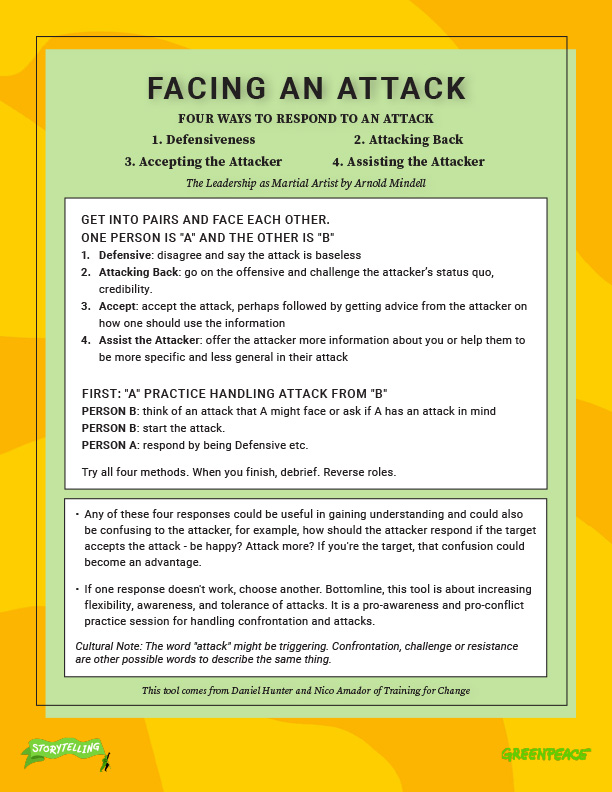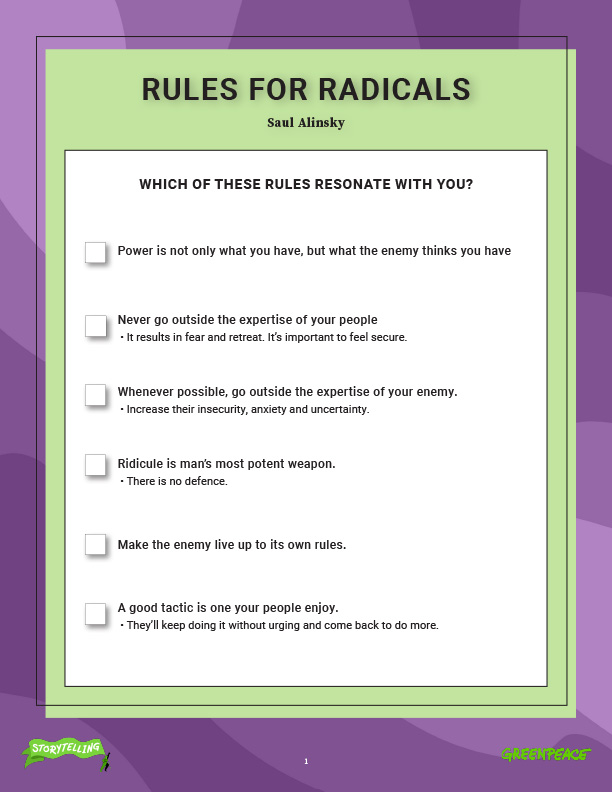STEP SEVEN: MORE CONSIDERATIONS
We all know that words are never neutral, and neither are images. They come laden with histories and symbols, and they can have real-world impacts on how we think and act. Below we’ve shared a few considerations that guide our storytelling that have not been covered directly by the rest of the guide.
GENDERED LANGUAGE

When at all possible, we find it’s helpful to use gender neutral language. The reasons for this are both philosophical and pragmatic. Greenpeace is working toward a world that honours the voices of women, men and people outside of the gender binary, and we try to honour that goal in the words we choose. And practically, selecting inclusive words helps to widen the audience of people who can see themselves in our stories.
So what does this mean in practice? Here are a few specific tips:
- Unless you’re talking about a specific person, the pronoun “they” works just as well as “he” or “she.” A good strategy is to opt for the plural: Instead of “a good storyteller knows his audience,” you could say “good storytellers know their audience.”
- The word “man” has a way of creeping into terms where it’s unnecessary and inaccurate. Be on the lookout for it. Why speak of “mankind” when “humanity” expresses the same concept more inclusively? Terms that name roles and professions are frequent offenders, but with a little thought (and maybe a thesaurus) you can always find gender neutral alternatives. “Chairman” becomes “chairperson,” “craftsman” becomes “artisan,” “cameraman” becomes “camera operator” or “videographer,” and “fireman” becomes “firefighter.”
- When talking about specific people, be conscious of the characteristics you choose to emphasise. Do you tend to describe men as “courageous” and women as “caring”? Both of these qualities are admirable, but both are attributed more often to one gender than the other. Try not to reinforce these assumptions, and look for opportunities to highlight “bold” women and “nurturing” men.
WAR METAPHORS

Conflict is an inherent part of activism. When you try to overhaul the status quo, you’ll find that not everyone will be happy about it. It can be tempting to couch your communications in the terminology of war. Your campaign becomes a “battlefield.” Your most outspoken activists are “bomb throwers.” A meeting with an antagonistic CEO takes place “behind enemy lines.”
Even though you’re speaking metaphorically—perhaps even with a sense of humour—there are some very good reasons to think carefully before evoking this kind of imagery:
- Battlefront language has a tendency to harden your opponent’s positions. When you frame them as an enemy to be vanquished (reasonable as that may be), they’re likely to view a change of heart as an unacceptable humiliation. However, if you talk about a problem that needs solving instead of a battle that needs winning, you leave the door open for them to reverse their positions. Even if they’re only trying to save face, these reversals can still be positive for your community.
- You know that you’re speaking metaphorically, but once your words are out in the world, you can’t dictate how they’ll be used or interpreted. Don’t be surprised if your opponent spins your communications to their own ends, issuing press releases that say “environmental activists have declared war on local job creators.” And as recent tragedies have demonstrated, violent rhetoric can spur unstable individuals to actual acts of violence. You don’t want any part of that.
- We might be biased—one half of our name is “peace” after all—but we find warlike terminology antithetical to the world we’re trying to build. This rhetoric reinforces a mindset where victories are zero-sum, where we only win when someone else loses, where the world is black and white and, on a grander scale, where war is an acceptable or even virtuous means for settling our differences. If we want to live in a more peaceful world, we need to create the vocabulary to express it.
COLONIAL MINDSETS

The legacy of colonialism runs deep around the world. No matter where you’re from, this history has shaped the products we buy, the foods we eat, the resources available to us and politics that govern us. The stories we tell and the language we use to tell them are not immune to this influence. Even well-meaning people can unconsciously create narratives that reinforce colonial mindsets. Here are a few strategies for telling stories that build power rather than exploit:
- Begin with relationships. Rather than entering a situation with the belief that you know what a community needs, talk to the people in that community. What are their goals and ambitions? What kind of help do they want from you? Their needs and desires should guide your path. Remember: They’re the protagonists of their own story. You’re a supporting character.
- Put the aims of the communities you work with over those of your organisation. Their problems are theirs to define. You might want to weave their work into a larger campaign for clean drinking water, but if their primary concern is tribal sovereignty, it’s your job to respect that. This isn’t to say there isn’t room to connect different issues where appropriate. Few problems are one-dimensional. However, you need to value and employ their frames rather than insist they adopt yours.
- People in frontline communities are not helpless victims in need of rescue. They are allies in the same cause. If you’re campaigning on behalf of a community that you don’t belong to, you need to be especially careful to represent them both accurately and respectfully. Their lives aren’t yours to sensationalise, even if you think it will generate more clicks.
- Be on the lookout for monolithic and paternalistic thinking. The world isn’t neatly defined into “developing” and “developed” nations. There is no unified category of “tribal societies.” We face global problems, but our situations are specific and our perspectives are of equal value. Honour that.
CHECKLIST GUIDE

Words aren’t neutral. Neither are our images. We want to tailor our messages in a way that maximises impact while staying true to the values that inspired us to do this work in the first place.
As we build our narrative through our communiques, press releases, social media posts and other storytelling tools, the following checklist can address potential blindspots and prevent harm in our storytelling.
- Did you investigate the narrative landscape around your issue? Have you asked frontline communities how they frame the problem, and adequately incorporated those frames into your narrative? Did you analyse your opponents’ frames, and consider how they can be strategically countered?
- Have you coordinated with allied organisations working on the same issue, both to find unifying themes to connect your narratives and to avoid redundancy in your efforts?
- At each stage of the storytelling process (brainstorming, planning, writing, etc.), do you involve people from diverse backgrounds in terms of race, gender, age, sexuality, disability and socioeconomic background? When soliciting feedback on ideas or specific communications, did you take care to demonstrate that you’re honestly open to critique?
- Have you carefully scrutinised your words to look for ways they could be misconstrued by the public, or even manipulated or distorted by your opponents?
- When sharing the stories of individuals, have you taken care to offer a diverse mix of protagonists? Are you alert to the ways your communications could accidentally reinforce stereotypes (e.g. characterising male activists as “brave” and female activists as “caring”)?
- Are your diction and cultural references appropriate for your target audience? Or does your terminology exclude some portion of the people you’re hoping to connect with?
- Have you thought carefully about the history and power dynamics involved in your specific issue? Have you taken care to ensure that your communications don’t accidentally strengthen frames and mindsets that you’re seeking to undermine?
- Does the specific goal of each piece of messaging support the larger story you’re attempting to tell?


